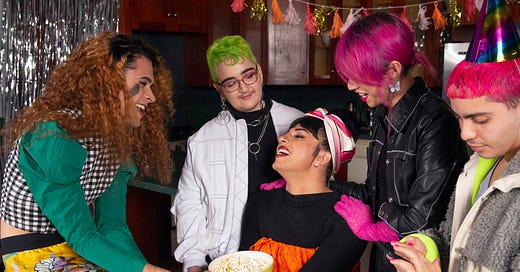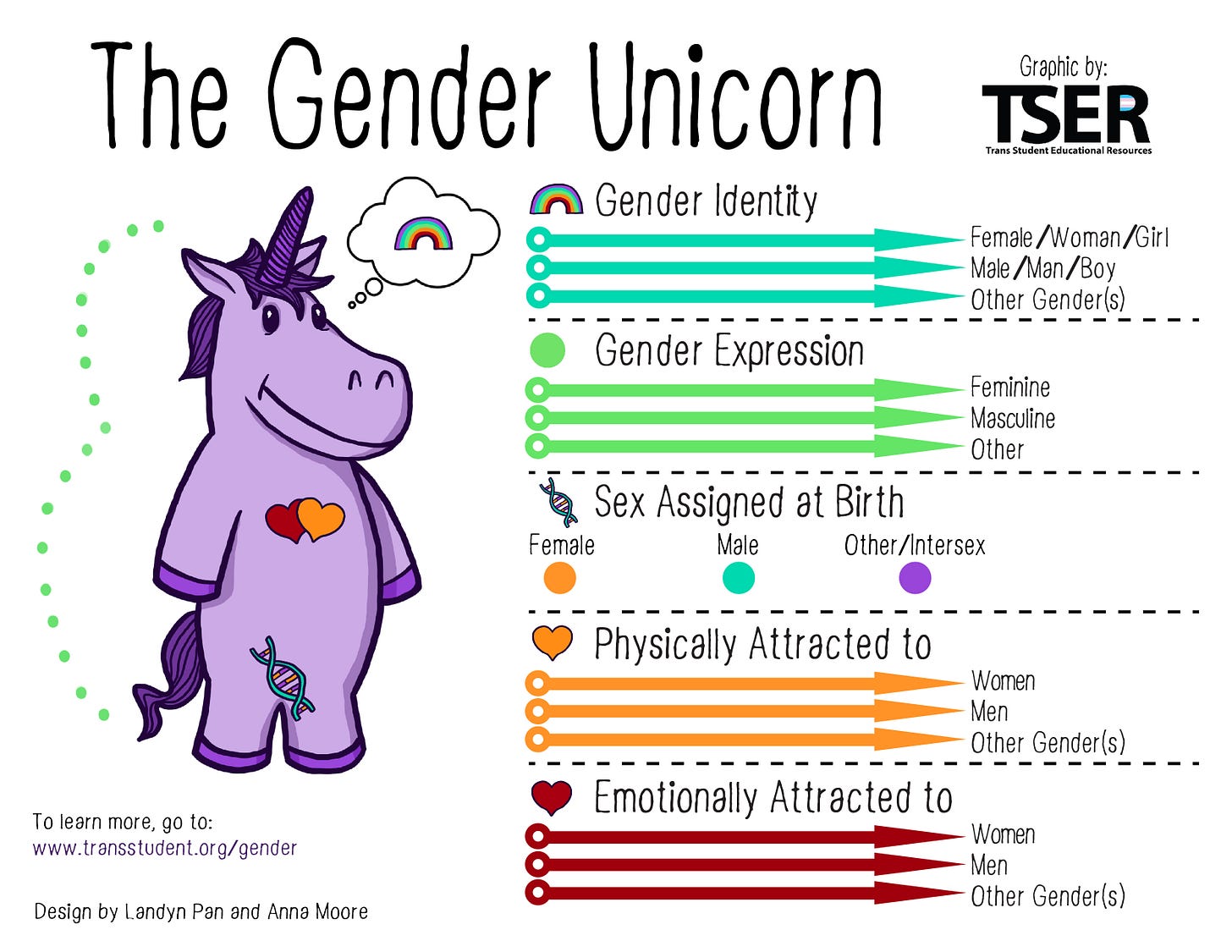[This is the 7th part of a series that examines gender from its origins - and herein we are arrived into the present era. The earlier parts can be found here. Here is an attempt to discover what prevails beneath the woken umbrella, and to just begin awakening to the implications of sanctioning its acceptance]
What in Genderation?!
“Gender” at the turn of the second millennium turned out to mean what one feels about oneself at a given time, and it had become synonymous with the term “gender identity” - and also in turn, with the identity one senses or establishes based on the “gender role” one willingly or unwillingly performs. Gender, which the uninitiated supposed described a stable innate binary quality – being whether you were male or female, had now become a matter of the mind, sundered from reality, biology and sex - and sex itself was contrived into a mental construct.
Gender, then, being as whimsical as the mind, changes - and even the status of transit is considered a gender in itself, and that itself can be graded and intersected into still more genders. Various sources list various numbers of genders, and the number is growing to ensure that no complex variant is not included.

Indefinable
The World Professional Association for Transgender Health (WPATH), formerly known as the Harry Benjamin[1] International Gender Dysphoria Association (HBIGDA), an advocacy organisation for the chemical and physical violation of sex-confused individuals so that they might acquire secondary and tertiary attributes of the sex they are not, in the current version 8 of their Standards of Care document (SOC8) circularly defines gender stating that “gender may reference gender identity, gender expression, and/or social gender role”[2].
WPATH’s definitions of gender expression – “how a person enacts or expresses their gender in everyday life and within the context of their culture and society. Expression of gender through physical appearance may include dress, hairstyle, accessories, cosmetics, hormonal and surgical interventions as well as mannerisms, speech, behavioral patterns, and names. A person’s gender expression may or may not conform to a person’s gender identity” is also circular, as is their definition of gender identity – “a person’s deeply felt, internal, intrinsic sense of their own gender”. Employing these in the definition of gender reveals circles within circles - and creative interpretations are open to phantasmic incoherence and comfortable perplexity.
The University of Berkeley California have a Gender Equity Resource Centre (GenEq) with a motto on their home page saying that “We are the one we have been waiting for”. Gender is defined in these de-hallowed halls of queer erudition as “socially constructed roles, behaviors, and attributes given to folks based on their assigned sex. Gender characteristics can change over time and are different between cultures”.
Berkeley’s GenEq also provide a definition for “Gender-Expansive”, being “an umbrella term used for individuals that broaden commonly held definitions of gender, including its expression, associated identities, and/or other perceived gender norms, in one or more aspects of their life.”[3]
Canada-based activist organization Equitas defines gender in its lexicon, as including “the power relation between women, men and any person whose appearance or behavior fails to conform to traditional male and female gender norms. Gender roles do not always reflect reality and may be based on stereotypes and reinforced in a community. The term gender is different from the term sex, which refers to the biological differences between men and women. Moreover, it is important to specify that social gendered roles can change and evolve.”
According to the LGBTQIA+ Wiki[4], the A could be asexual, aromantic, or even agender. Further, that “when people talk about nonbinary gender, they often find that there aren't any words for their experiences. This is called a lexical gap.”
Factors
It is evident then that contemporary ideas of gender have aspects of feelings, of physical libidinal romantic and emotional orientations inclinations and perversions, of sex itself, sexual characteristics, disorders of sex and sexual development, of fears and aspirations, of desires and priorities, of uncertainty rootlessness and change, and of expansion and narcissistic specification of individual convoluted identity - and the coining of a name for it. Further, gender identity is believed to be as much gender as identity, with identity expressed vested behaved performed in a role.
Belief among adrifts, that such ideas of identity are masters of one’s reality, that felt identity crowns natural essence and that virtue must submit to disordered will – rather than that the truth might be illuminated via the discernment of reality, and that self-restraint effloresces freedom, has coagulated into a pervasive international thrombus numbing and wasting humanity into a state of falseness, confusion, despair and venereal chaos – the legacy of Money, Kinsey, Freud, de Beauvoir, de Laurentis, Wilchins, Butler, Benjamin, Sanger, Stopes, Kissinger, Marx, Lenin, Hirshfield, Hefner, Foucault among numerous other children of the liar, servants of the adversary.
Samples
Xenogender[5] was coined by a Tumblr user calling himself Baaphomett, and it is classified as “a non-binary gender identity that cannot be contained by human understandings of gender [and is] more concerned with crafting other methods of gender categorisation and hierarchy such as those relating to animals, plants, or other creatures/things. Xeno-gender isn't defined in relation to female or male (the binary genders), but by other kinds of ideas that most people don't think of as having to do with gender.” Some xenogenders beginning with A include abime-gender – “a deep perhaps abysmal gender”, alien-gender and astral-gender. One also finds bog-gender, meow-gender and mermaid-gender - with options such as merboy, mergirl and merenby, among others.
Also, “Panfaunpronominalflux, also called panomnifaunpronominalflux or omnipanfaunpronominal, also sometimes shortened to panfaunflux, panomnifaun, and omnipanfaun is when one uses all pronouns besides traditionally feminine ones, including neopronouns. They are fluid from having a preference and having no preference for pronouns. As an example, one day the individual may prefer xey/xem pronouns, and the next day they don't prefer any pronouns. The individual may or may not have a lean on whether they have a preference or not, which can be specified via the spelling of the term. (Ex. one who has a lean on having preferences may specify that using the spelling omnipanfaunpronominal, whereas someone who leans on having no preference may use panomnifaunpronominal.) This is considered a subtype of faunpronominal, and may or may not be considered a subtype of omnifaunpronominal and/or panfaunpronominal. The traditionally feminine counterpart is panfaepronominalflux, and the traditionally neutral counterpart is panflorpronominalflux.” [6]
Further, that “some who have mental variations see these as an influence on - or an inseparable part of - their gender identity” and such neuro-genders include auti-gender, border-gender and skhizein-gender.
Medicine Net lists 72 genders[7] in a piece authored by Shaziya Allarakha, MD and reviewed by Pallavi Suyog Uttekar, MD. Included are “Adamas gender: A gender that is indefinable or indomitable. People identifying with this gender refuse to be categorized in any particular gender identity.”; Alexigender: a fluid gender identity between more than one type of gender although they cannot name the genders they feel fluid in; and Amaregender: a gender identity that changes depending on the person one is emotionally attached to – all under A.
Innumerable sources provide their own gender lists, even Disabled World[8], an online resource for the disabled which instructs that demigender is “a person whose gender identity is partially associated with a specific gender” while demisexual is “a person who feels sexual attraction only once a strong emotional bond is formed”, and diamoric is “a non-binary person who is attracted to non-binary people”. Healthline[9] lists 64 genders including gender-void.
Facebook initially expanded gender options in 2014 from 2 to 58[10] for Americans and then 71 for the British, including “asexual”, stating in 2015 that they “collaborated with our Network of Support, a group of leading LGBT advocacy organisations, to offer an extensive list of gender identities that many people use to describe themselves. Moreover, people who select a custom gender will now have the ability to choose the pronoun they’d like to be referred to publicly — male (he/his), female (she/her) or neutral (they/their).” Eventually the option of entering one’s own invented custom tailored gender was granted to those who yearn for “how cute” comments on their children’s or pets’ pictures, and “wow”s on their exotic real or virtual travel pictures, from covertly envious co-socialmediasts.
Analysis
Analysis of a soup can be sticky, and perhaps unpalatable when it is a bog. Aspiring and established philosophers have for decades articulated ideas employing the terms structuralism and post-structuralism, each one having their own sense of the same terms and a murkiness about when one has ended and the other began. An obliquity in gender itself which in the middle of the twentieth century was a synonym for sex and matters sexual, ramified and entangled in a seedbed of rebellious perversion into ethereal identities.
In the beginning, there was sex. It was real and it was male (M) and female (F). And they united and multiplied, via a conjugal self-giving, which is contemporarily described as “heterosexual”. Then pride and trauma gave rise to unnatural libidinous intentions and behaviour that mocked the union of spouses, and thereby another binary arose with the coming of “homosexual”, that included the G and L. Other aspects of “gender” still subsisted within the descriptions of masculinity and femininity. The idea of “fluidity” enabled transitions, and then there were trans (T) and detransitioners – as yet moving from one to another, but distinguishable from the ineptly termed cis (C). There were other binaries as well – gender fluid and gender constant; and champions of in-born innate gender and the heroes of gender as socially constructed. For some it was imposed by society, while for others they performed themselves into it.
Even as chaos fluttered, by and by pride demanded that there shall be both and not one or the other, and a lusty B joined G and L, and then some were deluded into believing that they could be both male and female either simultaneously or sequentially. One perhaps was not yet post-structuralist when the mixtures of two might be possessed in varying amounts, or one might be situated in between – whether in terms of sex, social behaviour, venereal attractions, or mere romantic or affectional proclivities.
It would be rather queer (Q), however, to have more than two extremes of the same general parameter, and one thereby may encounter the M-spec pluralians (M for multi) and even the totalians such as “pansexual” practitioners. In contrast to all, there are also the null who may have no gender or the lack of some aspect of it. The non-conformity demanded by queer pride discursively proliferates new genders, new combinations and even deems uncertainty of one’s gender as a gender - even classifying xenogenders which are said to be beyond human comprehension, or least vague in the mind of the possessor of such xenine ambigenders.
The unreal insane and unchaste manifestations of the complexity of a human person is manifested by the intersectionality of queered genders where one might be transitioning from a horse to a tortoise/chair mix, dressed with wings on its wattle, having amorous engagements with orchids and human babies, and feeling like a star in Andromeda – but transitioning into the Milky Way.
The nulls or voids (A), the mixtures, the fluids, the spectra and intersections and in-betweens among all these populate the unlimited Q matrix and are very much +, ably supported by the indefinable – and the abrogendered whose gender changes so fast that it can’t be pinned down.
Inclusive to the +, are not merely furry identities and transinfants, but also carnal gratification extended beyond adult G, L, B into pederasty presbyorasty and the seeking of ecstasy among corpses and inanimate objects - in addition to bestiality and self-abuse.
End
Gender is vague, ambiguous, subjective and circularly defined with reference to itself. It may be one’s protean, transient whims, mood, disposition, temperament, psychological personality – felt or acted. It is untethered feelings become identity, where the social mental construction is real - and reality is false.
The gender multiverse is blissfully celebrated by the intelligent, the influential and the powerful as much as by its lay victims. Gender equality is the rallying call at corporates - and diversity privileges have only begun with the unfair advantages gifted to women. Inclusivity will need to include the androgynous foal that lusts for zebras – and the elimination of the gender pay gap and other parities will need to extend unbiased to the plethora of genders. The pot-pourri of genders will boil over and civilisation will be fried in its putrescence – unless the brave and the sane will bedeck in maille, and mount and ride with emblazoned pennant awind, in the defence of truth and virtue.

[1] of SSSS fame, cf. Money’s orgies:
[2] https://www.tandfonline.com/doi/pdf/10.1080/26895269.2022.2100644
[3] https://cejce.berkeley.edu/centers/gender-equity-resource-center/resources/educational-resources/terms-and-definitions
[4] https://lgbtqia.wiki/wiki/LGBTQIA%2B_Wiki
[5] according to LGBTQIA+ Wiki
[6] https://lgbtqia.wiki/wiki/Panfaunpronominalflux
[7] https://www.medicinenet.com/what_are_the_72_other_genders/article.htm (accessed in April 2025)
[8] https://www.disabled-world.com/disability/sexuality/lgbt/gender-identities.php (accessed in April 2025)
[9] https://www.healthline.com/health/different-genders (accessed in April 2025)
[10] https://abcnews.go.com/blogs/headlines/2014/02/heres-a-list-of-58-gender-options-for-facebook-users









